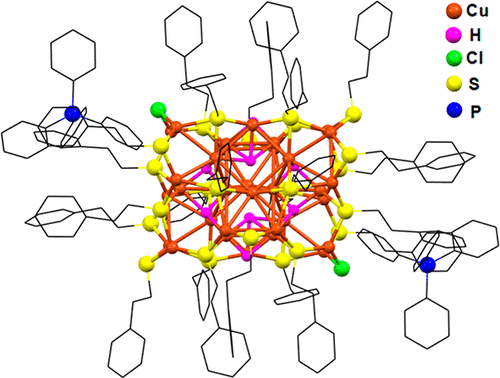当前位置:
X-MOL 学术
›
J. Am. Chem. Soc.
›
论文详情
Our official English website, www.x-mol.net, welcomes your
feedback! (Note: you will need to create a separate account there.)
[Cu32(PET)24H8Cl2](PPh4)2: A Copper Hydride Nanocluster with a Bisquare Antiprismatic Core
Journal of the American Chemical Society ( IF 14.4 ) Pub Date : 2020-07-16 , DOI: 10.1021/jacs.0c06577 Sanghwa Lee 1, 2 , Megalamane S Bootharaju 1, 2 , Guocheng Deng 3 , Sami Malola 4 , Woonhyuk Baek 1, 2 , Hannu Häkkinen 4 , Nanfeng Zheng 3 , Taeghwan Hyeon 1, 2
Journal of the American Chemical Society ( IF 14.4 ) Pub Date : 2020-07-16 , DOI: 10.1021/jacs.0c06577 Sanghwa Lee 1, 2 , Megalamane S Bootharaju 1, 2 , Guocheng Deng 3 , Sami Malola 4 , Woonhyuk Baek 1, 2 , Hannu Häkkinen 4 , Nanfeng Zheng 3 , Taeghwan Hyeon 1, 2
Affiliation

|
Atomically precise coinage metal (Au, Ag and Cu) nanoclusters (NCs) have been the subject of immense interest for their intriguing structural, photophysical and catalytic properties. However, the synthesis of Cu NCs is highly challenging because of low reduction potential and high reactivity of copper, demonstrating the need for new synthetic methods using appropriate ligand combinations. By designing a diamine-assisted synthetic strategy, here we report the synthesis and total structure characterization of a box-like dianionic Cu NC, [Cu32(PET)24H8Cl2](PPh4)2 co-protected by 2-phenylethanethiolate (PET), hydride and chloride ligands. Its crystal structure comprises a rare bisquare antiprismatic Cu14H8 core, assembled by two square antiprisms by edge-sharing followed by hydride binding. The rod-shaped Cu14H8 core is clamped by two complex Cu7(PET)11Cl and two simple Cu2PET metal ligand frameworks, constructing the complete structure of Cu32 NC. The presence, number and location of hydrides are established by combined experimental and density functional theory results. The electronic structure calculations show the cluster as a zero-free-electron system, reproduce well the measured optical absorption spectrum and explain the main absorption features. Furthermore, the Cu32 cluster is found to be a highly active homogeneous catalyst for the C-N bond formation in aniline carbonylation reaction at room temperature. We hope that new findings in this work will stimulate and expand the research on Cu and other active metal NCs.
中文翻译:

[Cu32(PET)24H8Cl2](PPh4)2:具有双方形反棱镜核的氢化铜纳米团簇
原子精确的铸币金属(Au、Ag 和 Cu)纳米团簇(NCs)因其有趣的结构、光物理和催化特性而备受关注。然而,由于铜的还原电位低和反应性高,Cu NCs 的合成极具挑战性,这表明需要使用适当的配体组合的新合成方法。通过设计二胺辅助合成策略,我们报告了盒状双阴离子 Cu NC,[Cu32(PET)24H8Cl2](PPh4)2 由 2-苯基乙硫醇 (PET)、氢化物共同保护的合成和总结构表征和氯化物配体。它的晶体结构包括一个罕见的双方形反棱镜 Cu14H8 核,由两个方形反棱镜通过边缘共享和氢化物结合组装而成。棒状的Cu14H8核被两个复杂的Cu7(PET)11Cl和两个简单的Cu2PET金属配体骨架夹住,构成了Cu32 NC的完整结构。氢化物的存在、数量和位置是通过结合实验和密度泛函理论结果确定的。电子结构计算表明该团簇是一个零自由电子系统,很好地再现了测量的光吸收光谱并解释了主要的吸收特征。此外,发现 Cu32 簇是室温下苯胺羰基化反应中 CN 键形成的高活性均相催化剂。我们希望这项工作的新发现将刺激和扩展对 Cu 和其他活性金属 NCs 的研究。氢化物的数量和位置是通过结合实验和密度泛函理论结果确定的。电子结构计算表明该团簇是一个零自由电子系统,很好地再现了测量的光吸收光谱并解释了主要的吸收特征。此外,发现 Cu32 簇是室温下苯胺羰基化反应中 CN 键形成的高活性均相催化剂。我们希望这项工作的新发现将刺激和扩展对 Cu 和其他活性金属 NCs 的研究。氢化物的数量和位置是通过结合实验和密度泛函理论结果确定的。电子结构计算表明该团簇是一个零自由电子系统,很好地再现了测量的光吸收光谱并解释了主要的吸收特征。此外,发现 Cu32 簇是室温下苯胺羰基化反应中 CN 键形成的高活性均相催化剂。我们希望这项工作的新发现将刺激和扩展对 Cu 和其他活性金属 NCs 的研究。很好地再现了测量的光吸收光谱并解释了主要的吸收特征。此外,发现 Cu32 簇是室温下苯胺羰基化反应中 CN 键形成的高活性均相催化剂。我们希望这项工作的新发现将刺激和扩展对 Cu 和其他活性金属 NCs 的研究。很好地再现了测量的光吸收光谱并解释了主要的吸收特征。此外,发现 Cu32 簇是室温下苯胺羰基化反应中 CN 键形成的高活性均相催化剂。我们希望这项工作的新发现将刺激和扩展对 Cu 和其他活性金属 NCs 的研究。
更新日期:2020-07-16
中文翻译:

[Cu32(PET)24H8Cl2](PPh4)2:具有双方形反棱镜核的氢化铜纳米团簇
原子精确的铸币金属(Au、Ag 和 Cu)纳米团簇(NCs)因其有趣的结构、光物理和催化特性而备受关注。然而,由于铜的还原电位低和反应性高,Cu NCs 的合成极具挑战性,这表明需要使用适当的配体组合的新合成方法。通过设计二胺辅助合成策略,我们报告了盒状双阴离子 Cu NC,[Cu32(PET)24H8Cl2](PPh4)2 由 2-苯基乙硫醇 (PET)、氢化物共同保护的合成和总结构表征和氯化物配体。它的晶体结构包括一个罕见的双方形反棱镜 Cu14H8 核,由两个方形反棱镜通过边缘共享和氢化物结合组装而成。棒状的Cu14H8核被两个复杂的Cu7(PET)11Cl和两个简单的Cu2PET金属配体骨架夹住,构成了Cu32 NC的完整结构。氢化物的存在、数量和位置是通过结合实验和密度泛函理论结果确定的。电子结构计算表明该团簇是一个零自由电子系统,很好地再现了测量的光吸收光谱并解释了主要的吸收特征。此外,发现 Cu32 簇是室温下苯胺羰基化反应中 CN 键形成的高活性均相催化剂。我们希望这项工作的新发现将刺激和扩展对 Cu 和其他活性金属 NCs 的研究。氢化物的数量和位置是通过结合实验和密度泛函理论结果确定的。电子结构计算表明该团簇是一个零自由电子系统,很好地再现了测量的光吸收光谱并解释了主要的吸收特征。此外,发现 Cu32 簇是室温下苯胺羰基化反应中 CN 键形成的高活性均相催化剂。我们希望这项工作的新发现将刺激和扩展对 Cu 和其他活性金属 NCs 的研究。氢化物的数量和位置是通过结合实验和密度泛函理论结果确定的。电子结构计算表明该团簇是一个零自由电子系统,很好地再现了测量的光吸收光谱并解释了主要的吸收特征。此外,发现 Cu32 簇是室温下苯胺羰基化反应中 CN 键形成的高活性均相催化剂。我们希望这项工作的新发现将刺激和扩展对 Cu 和其他活性金属 NCs 的研究。很好地再现了测量的光吸收光谱并解释了主要的吸收特征。此外,发现 Cu32 簇是室温下苯胺羰基化反应中 CN 键形成的高活性均相催化剂。我们希望这项工作的新发现将刺激和扩展对 Cu 和其他活性金属 NCs 的研究。很好地再现了测量的光吸收光谱并解释了主要的吸收特征。此外,发现 Cu32 簇是室温下苯胺羰基化反应中 CN 键形成的高活性均相催化剂。我们希望这项工作的新发现将刺激和扩展对 Cu 和其他活性金属 NCs 的研究。











































 京公网安备 11010802027423号
京公网安备 11010802027423号